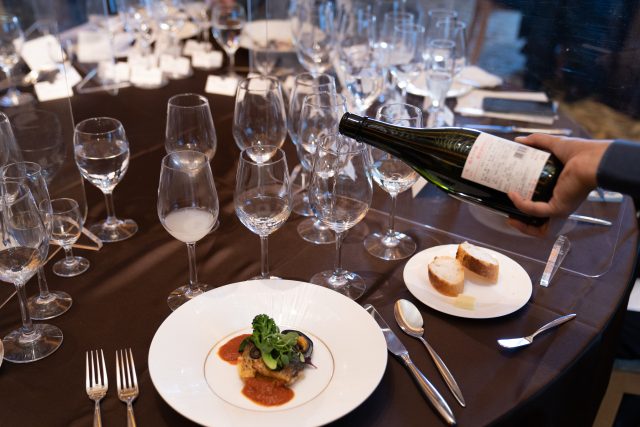This website uses cookies so that we can provide you with the best user experience possible. Cookie information is stored in your browser and performs functions such as recognising you when you return to our website and helping our team to understand which sections of the website you find most interesting and useful.
Sake makers association looks towards international markets for Sake Day
The Japan Sake and Shochu Makers Association prepares to mark Sake Day on 1 October, with plans to extend the category’s global reach.

For nearly 50 years, the Japan Sake and Shochu Makers Association (JSS) has promoted 1 October as Sake Day. It references centuries of history: for decades it was the start of the brewing year, and long before that October’s zodiac symbol was a sake jar. This year, however, the JSS is looking forward and outward.
Japan’s sake history is beyond doubt and its unique techniques are so respected that the traditional knowledge and skills of sake-making with koji mold in Japan has been proposed as UNESCO Intangible Cultural Heritage. Yet the last 50 years have changed the industry’s attitudes.
There has been a steady decline in domestic consumption, especially of entry level products, balanced by a growing premium market share and record export levels. For the JSS, this has been a clear sign that sake, as a global category, needs to expand its influence. On the other hand, exports reached a record high for the 13th consecutive year, exporting approximately 4 million 9L cases or 47.5 billion yen to 72 countries and regions in FY2022.
In terms of volume, this represents 8% of total sake shipments combining both domestic and exports. In addition, the CAGR of export value over the past 10 years from 2013 to 2022 was +18%, with export value expanding 4.5 times over this 10-year period. In addition, the unit export price per 720ml bottle in 2022 was 953 Yen, more than double the 2013 price, indicating that high-quality sake has been actively exported.
In addition, in terms of export value by region in 2022, Asia and North America account for 90% of the total, with Asia accounting for 65% and North America 25%, respectively, while Europe accounts for 6%.
Sake is often consumed at Japanese restaurants abroad. The increase in the number of Japanese restaurants has led to a rapid rise, with the count reaching 159,000 restaurants by 2021, nearly tripling since 2013. This growth in Japanese restaurants and the expansion of sake exports are closely correlated.
Commenting on the change in perception of sake in the U.S. over the past five years, U.S. Master Sommelier Evan Goldstein said: “There has been a tremendous change in the perception of sake in the U.S. In the past, sake was served exclusively in Japanese restaurants and often served hot. However, in recent years, there has been an increase in establishments outside of Japanese restaurants that offer Japanese sake, with some offering a wide variety (often more than 12 types) of sake.”
The JSS has been promoting sake in its domestic activities for the Sake Day, 1 October every year. For this year, they have organised prize draws to promote local sake, a festival introducing chocolate pairings and a Youtube-hosted event to share a toast across the country and overseas. Yet a key concern will be promoting the quality of sake, Japan’s national drink, around the world.
Top of the agenda is reiterating the market position of sake. As a fermented product, it sits closer to wine than spirits, but many associate it with the latter stronger products. For the JSS, emphasising the basics is key to developing the product’s following.
Akin to winemaking, the sake industry is heavily agricultural. The quality of rice determines the quality of the end product. Sakamai (sake rice) offers much higher suitability for premium sake making than table rice (designed for eating).
Much like grapes, there are several varieties, each bringing a unique character to the product. The most substantial difference between the two industries is in production location; unlike grapes, rice travels well. This means high-quality sake can be produced far from the rice fields, and all over Japan.
Wine offers a further analogy, in its potential for food pairing. Japanese cuisine has gained an international reputation, even making it onto the list of UNESCO Intangible Cultural Heritage in 2013. Between then and 2022, the number of Japanese restaurants offer the first chance to get sake onto drinks menus; the next stage is to reach non-Japanese restaurants.
Although not yet common practice, the leading lights of the wine world are noticing. “There has been a rise in restaurants that not only pair sake with Japanese cuisine but also incorporate it into Western-style meals”, continued Evan Goldstein MS. “While there is still a need for further education, I think sake will become a mainstream alcoholic beverage in the future.”
Above all, Sake Day 2023 serves as a celebration of the category. JSS is pleased to see the spread of sake making around the world, and they hope that the opportunity to toast with sake on Sake Day will spread around the world.
According to Hitoshi Utsunomiya, director of the JSS, consumers are viewing sake “as a new alcoholic beverage to be enjoyed with meals.”
Despite the centuries of tradition, Sake Day 2023 is an opportunity to see the category with fresh eyes.

